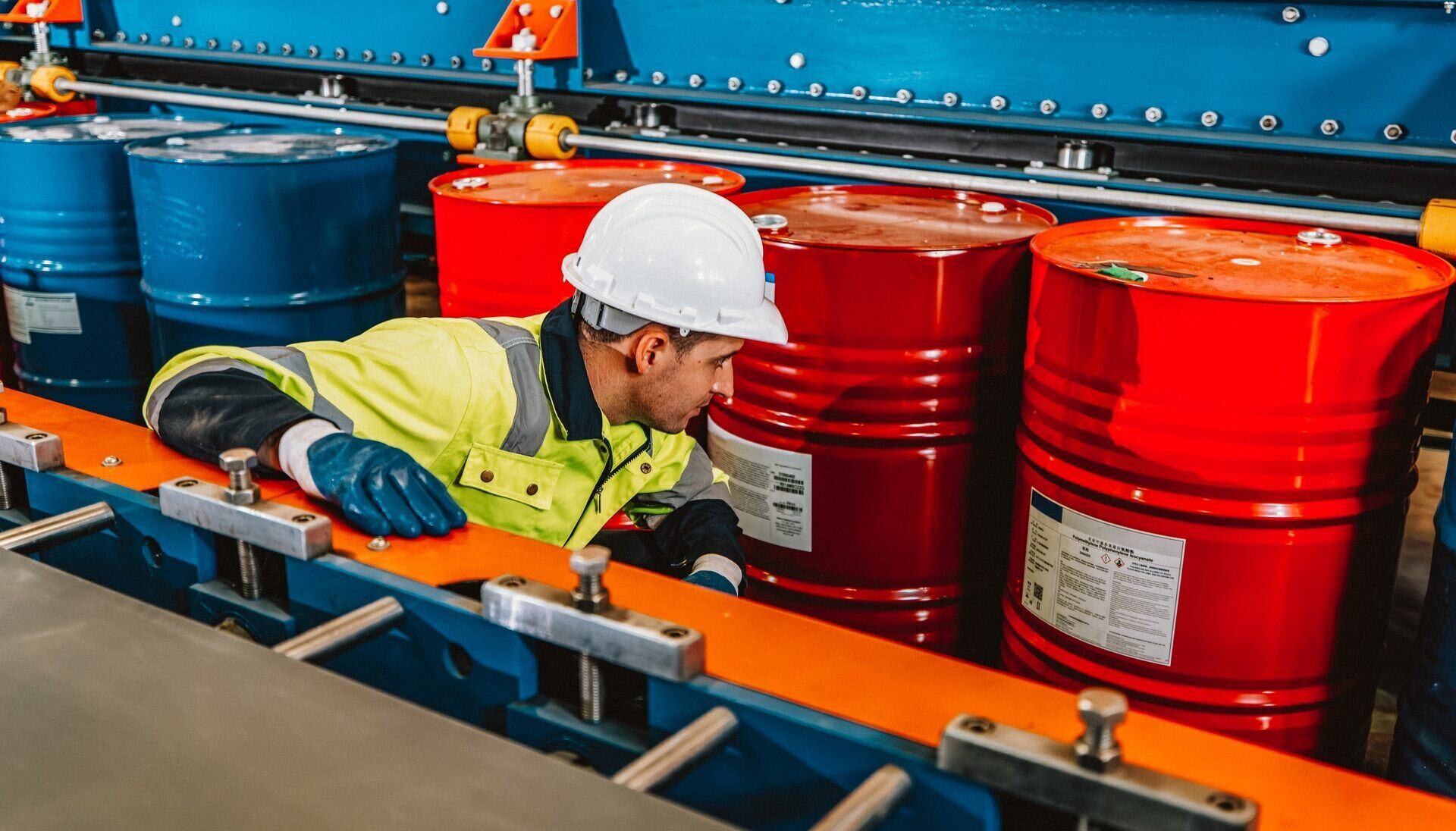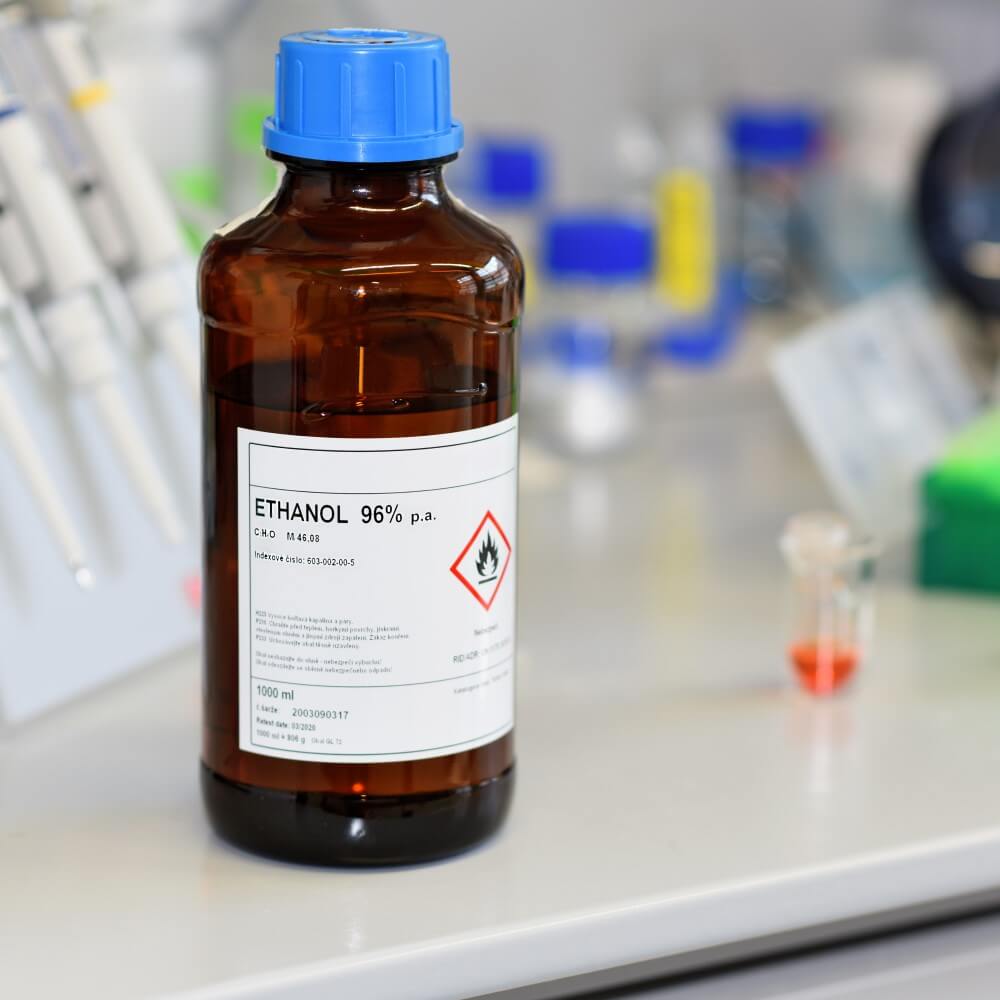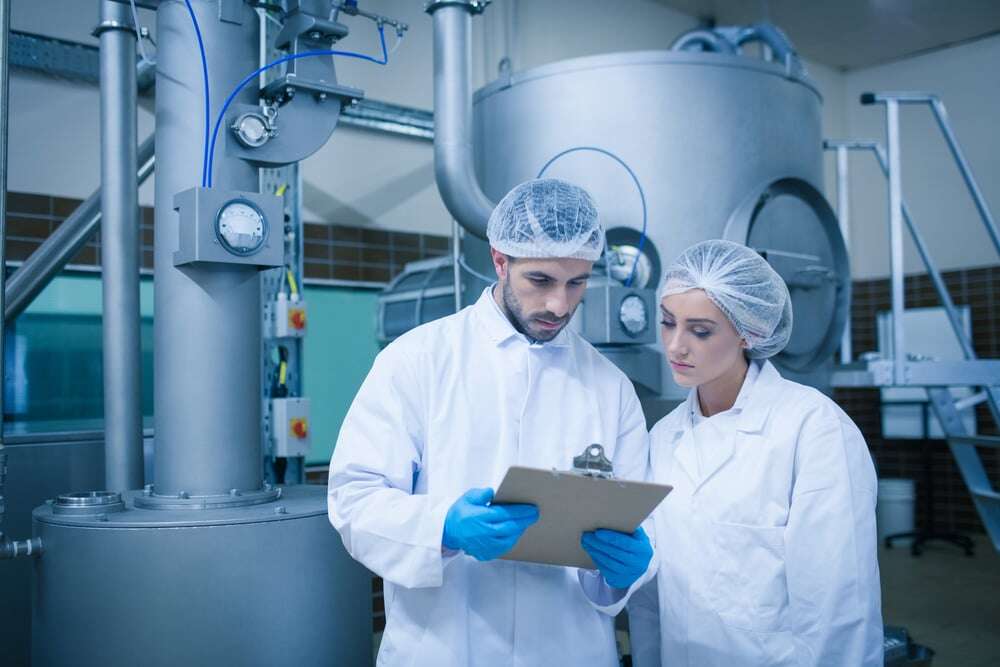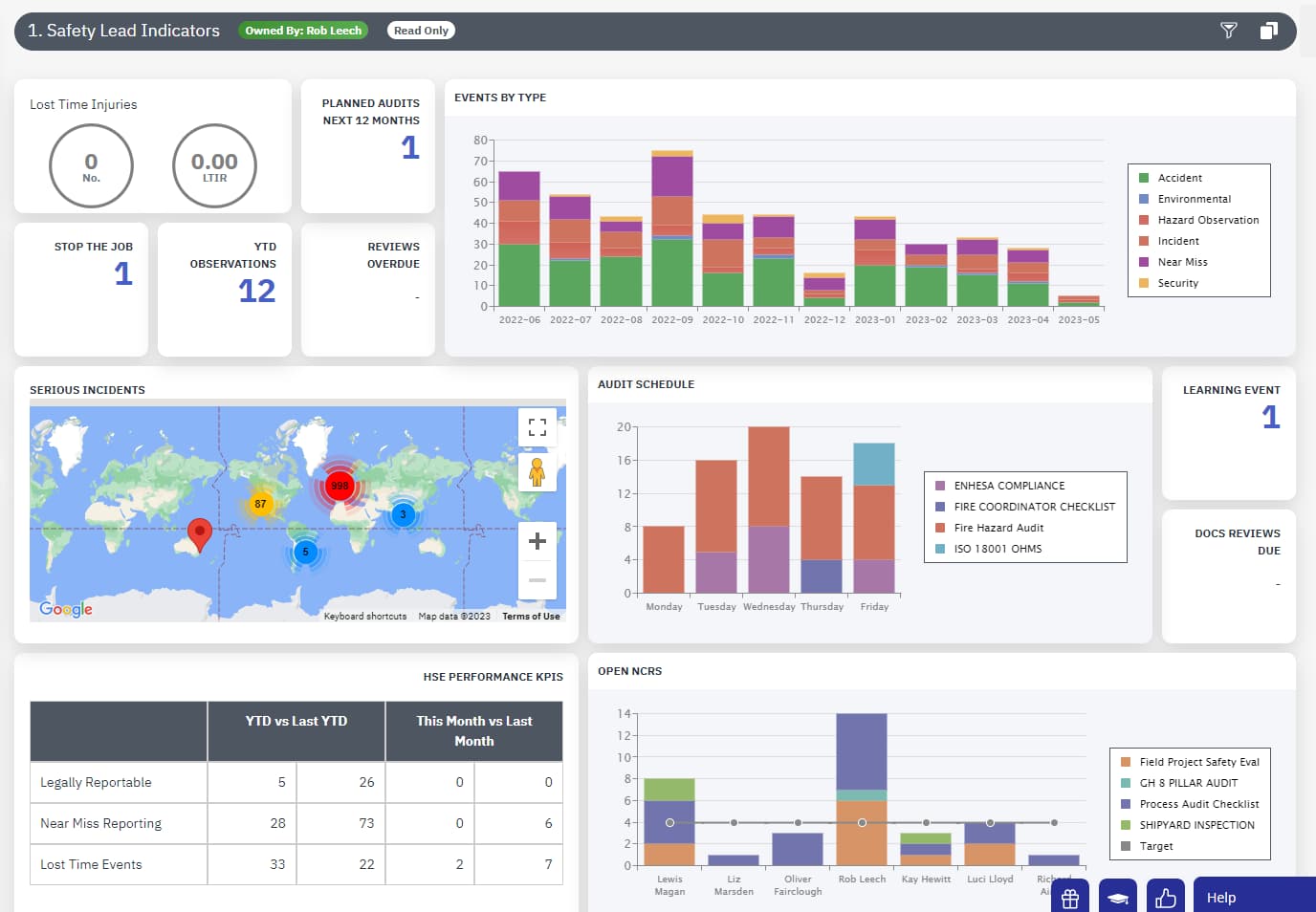What is the meaning of COSHH (The Control of Substances Hazardous to Health)?
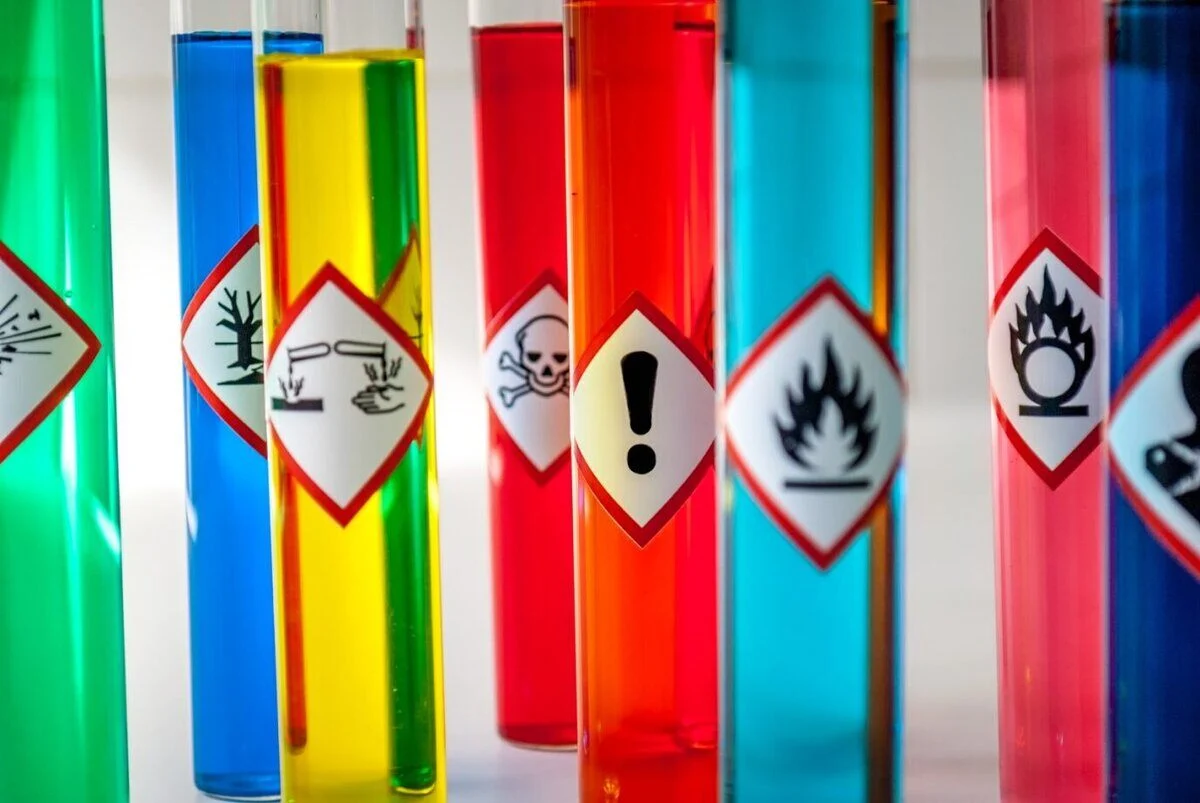
It has been revealed that there is unsafe and uncontrolled chemical use in 71% of substances. What’s more, 17% of EU workers report handling chemical products or substances for at least 25% of their working life.
Some chemicals are classified as hazardous and can be extremely harmful. Your job is to identify these chemicals and ensure control measures are put in place so workers and the environment remain protected. It is crucial to identify how a chemical or substance can affect employees, how it can affect processes, and the impact it may have on the environment. This helps to keep employees and the surrounding environment safe from substances hazardous to health. It is also a legal requirement if you are living in the United Kingdom.
Whether you’re looking for more information on COSHH or a way to streamline COSHH management, you’re in the right place!
What is the meaning of COSHH: Table of contents
Click on a specific section below to easily navigate to that area:
- 1. What is COSHH? What does COSHH stand for?
- 2. What are your COSHH responsibilities?
- 3. What are the COSHH regulations?
- 4. What does COSHH identify as hazardous substances?
- 5. COSHH hazard symbols
- 6. Routes of exposure
- 7. What is a Workplace Exposure Limit (WEL)
- 8. COSHH risk assessments
- 9. The Ultimate Guide to COSHH Management
- 10. How to manage chemical risk
- 11. 3 common mistakes of hazardous substances management
- 12. COSHH assessment software
- 13. COSHH case study
What is COSHH? What does COSHH stand for?
One of the first questions you might be asking yourself is what is COSHH? What does COSHH stand for? COSHH means the Control of Substances Hazardous to Health. This refers to a law in the United Kingdom which provides guidance to employers on how to protect employees from exposure to substances hazardous to health.
This is a law that employers and employees must follow to control substances that are hazardous in the workplace. COSHH identifies chemicals that are hazardous to health, although most companies will also identify chemicals with physical or environmental hazards associated with them. COSHH is applicable to the UK market and comes from the following regulation: COSHH Control of Substances Hazardous to Health Regulations, 2002.
When was COSHH introduced?
First introduced in 1988 and coming into force the following year on 1st October 1989, COSHH was originally put in place to offer more detail to the Health and Safety at Work Act 1974. It has now evolved to the Control of Substances Hazardous to Health Regulations 2002 (COSHH regulations 2002), which all UK organisations must follow to create a safer working environment. There are a number of COSHH regulations which employers must fulfil, including regulations 6-13.
Why is Control of Substances Hazardous to Health (COSHH) important?
You might be wondering what this has to do with you – why is COSHH important? COSHH is important not only because it is a legal requirement, but also because it provides guidance on how to protect teams from hazardous substances at work. Organisations that breach the COSHH regulations face serious consequences, which can include hefty fines, lawsuits via civil action, or possible imprisonment. It’s essential that employers and employees follow these regulations to efficiently:
- protect teams from injuries and illnesses
- remain compliant with UK regulations
- avoid hefty fines that could cost you – one organisation was fined £800,000 when three employees developed a lung condition because they were exposed to mist from metal fluid
How does Control of Substances Hazardous to Health (COSHH) promote safety?
So just how does COSHH promote safety? It provides clear steps on what actions are needed to prevent hazardous workplace exposures, leading to a safer and happier work environment. COSHH outlines the duties of an employer and exactly what is expected of them.
By identifying all hazardous substances, conducting COSHH risk assessments, providing employee training and more, COSHH aims to reduce the number of illnesses and incidents on site relating to substances hazardous to health. Being COSHH compliant will help elevate the standard of health and safety at your organisation and show your employees and other businesses that you take the health and safety of your teams seriously.
What are your COSHH responsibilities?
Every employer’s priority is keeping their employees safe; however, is COSHH entirely the responsibility of the employer? No! It’s a common misconception that all COSHH responsibilities fall solely on the employer. Both the employer and employees have responsibilities they need to fulfil.
Hazardous substances are all around us. In your place of work do you have:
- cleaning products?
- oils or lubricants?
- paints and adhesives?
- chemicals that you process?
- biological materials?
- chemical waste?
- gases?
If you answered yes to any of the above, you need to comply with COSHH regulations. Every employer’s priority is keeping their employees safe; however, is COSHH entirely the responsibility of the employer? No! It’s a common misconception that all COSHH responsibilities fall solely on the employer. Both the employer and employees have responsibilities they need to fulfil.
An employer has the following responsibilities:
- Implement control measures to protect workers from hazardous substances.
- Prevent or adequately control exposure to hazardous substances (So Far As Is Reasonably Practicable – SFAIRP).
- Provide employees with suitable and sufficient information, instruction, training, and appropriate protective equipment where necessary.
- Ensure that control measures are maintained, kept in full working order, and in a clean condition where appropriate.
- Draw up plans and procedures to deal with accidents and emergencies involving hazardous substances.
- Ensure that any employees exposed to hazardous substances whilst at work are under suitable health surveillance.
- Ensure that substances do not exceed the Workplace Exposure Limit (WEL).
- Carry out a COSHH risk assessment.
An employee has the following responsibilities:
- Make use of control measures and facilities provided by the employer.
- Ensure equipment is returned and stored properly, and report any defects or insufficiencies in control measures.
- Wear and store personal protective equipment (PPE) and remove any PPE that could cause contamination before eating or drinking.
- Make proper use of washing, showering, and bathing facilities when required.
- Maintain a high level of personal hygiene.
- Comply with any information, instruction, or training that is provided.
Every person, no matter their position, has a vital role to play in creating a safer work environment.
What are the COSHH regulations?
So just what are the COSHH regulations? They are a set of rules tailored to protect your people from exposure to hazardous substances. More specifically, regulations 6-13 are rules which employers must follow to keep their teams safe.
Let’s take a closer look at each:
- Regulation 6: Create and implement a written risk assessment for any potential workplace exposure.
- Regulation 7: Prevent and control exposure to substances hazardous to health at the workplace, regardless of the route of exposure.
- Regulation 8: Make sure all employees are implementing the controls put in place and reporting any deficiencies found.
- Regulation 9: Check all control measures are maintained.
- Regulation 10 and 11: Provide health surveillance and monitor employees if exposed to a hazardous substance.
- Regulation 12: Train and communicate all the necessary information to employees about these substances hazardous to health and their respective COSHH assessments.
- Regulation 13: Have emergency procedures in place in the event of an accidental exposure event, fire, spillage, or first-aid.
What does COSHH identify as hazardous substances?
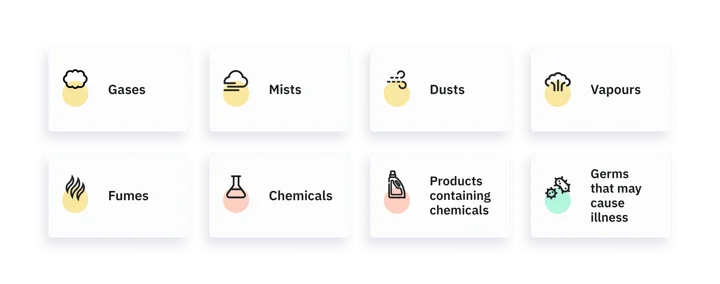
There are many substances hazardous to health covered by the Control of Substances Hazardous to Health (COSHH). COSHH substances are identified by the potential to cause harm because of their associated health hazards. A substance that might not normally be considered hazardous can become harmful depending on the way it is being used.
One of the first elements important to understand to fulfil your COSHH responsibilities is what are COSHH hazardous substances? Under COSHH, substances hazardous to health are materials which could harm individuals. This could be because the substances themselves have associated COSHH hazards. These COSHH chemicals could also be considered harmful depending on the way they are being used.
Which hazardous substances does COSHH not cover?
COSHH substances could come in several forms which range from gases to biological hazards. So, what is not covered by COSHH? There are certain materials that COSHH does not cover which you should be aware of. These are asbestos, lead and radioactive substances.

COSHH hazard symbols
The first step needed to fulfil your duties is recognising which chemicals are dangerous and which are not. This information can be found in the classification system. As you may already know, in 2015 the classification system for chemicals changed from the old CHIP system to the new CLP Regulations, which is part of the Globally Harmonised System of Classification.
As the name implies, the aim is to have a unified system used worldwide to give a common understanding to these chemicals. The old-style orange/yellow square symbols have been replaced by red bordered diamond pictograms.
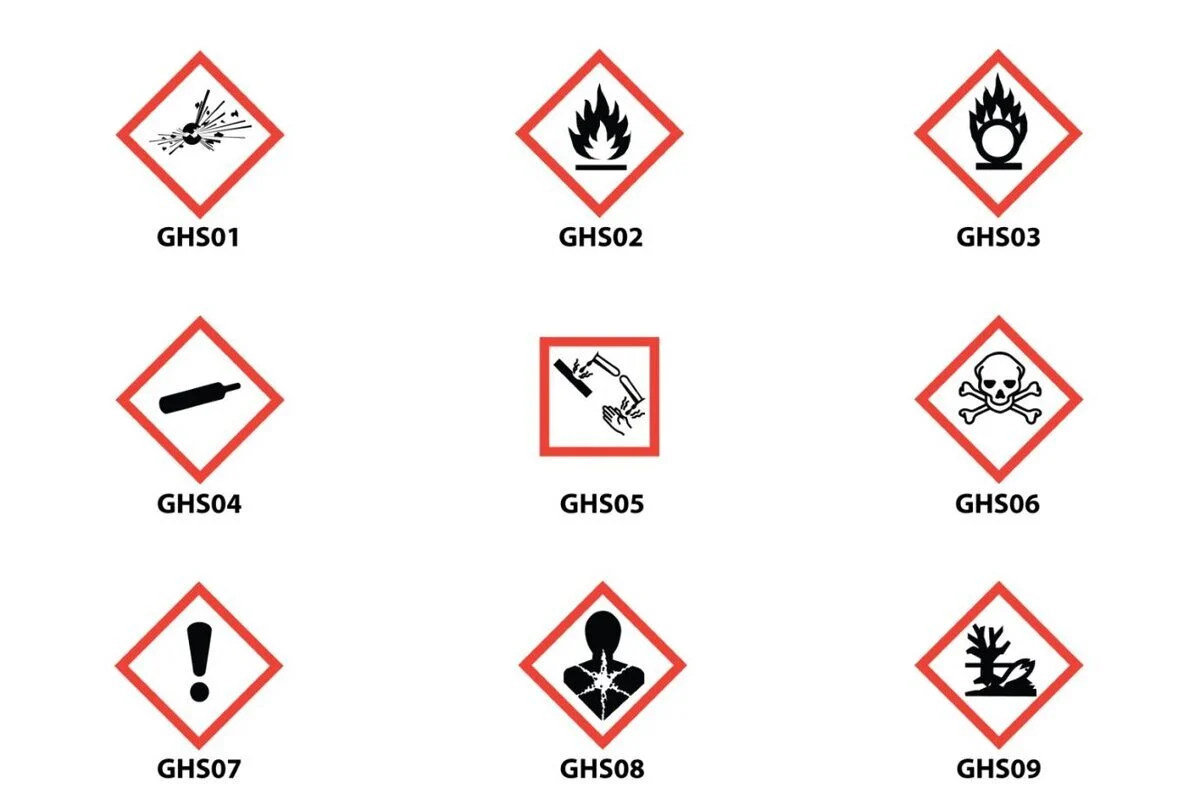
Another way to identify whether substances are harmful is to look at their respective COSHH labels or COSHH pictograms. There are 9 standard COSHH symbols which represent potential hazards. Hazard pictograms were created so people around the world could rely on a single system to recognise harmful hazards.
A chemical may have multiple hazards and pictograms associated with it. These combine to form the classification of the chemical. The classification information for the chemical can be found in section 2 of the safety data sheet and is also on the product’s label.
The classification is broken down into three categories: health hazards, physical hazards, and environmental hazards. Discover more about COSHH symbols and meanings, COSHH labelling, and other COSHH elements in our blog, Hazard Pictograms and What They Mean.
Routes of exposure
Now that you have a better understanding of COSHH labels and how to recognise a hazardous substance, it’s time to dive into the different routes of exposure hazardous substances can have. These substances can come in various forms such as dust, liquids, gases, etc.
Individuals can be exposed to hazards via four main routes of entry:
- Inhalation: Breathing in contaminated air is the most common way workplace chemicals enter the body. Chemicals may be in the form of gases, vapour, dust or mist. Once chemicals are inhaled, they can enter our lungs and be absorbed into the bloodstream. Different chemicals can then target different organs.
- Absorption: Some chemicals, by direct or indirect contact, can damage the skin and/or eyes or pass through them into the bloodstream. Broken, cut, or cracked skin will allow substances to enter the body more easily. Sometimes rashes can occur, and skin irritations may develop over time through frequent use. Do you have safety steps and procedures in place at your organisation if someone is exposed to a hazardous substance in their eyes? Timing is everything in such a serious situation, and having eye wash stations, for example, and procedures to assist injured employees is a must.
- Ingestion: This route of exposure, where a substance may be ingested through the mouth, is one people often dismiss as something that is highly unlikely. However, workplace chemicals may be swallowed accidentally if hands are contaminated (e.g. smoking cigarettes that have come in contact with a chemical or dirty hands). Substances can be absorbed into the blood and then transported to the rest of the body. A key method to mitigate such serious safety incidents is to have a workplace policy and culture to wash hands frequently and thoroughly. In addition, staff should be informed of the correct methods for wearing and removing gloves.
- Injection: Injection can occur when a sharp object (e.g. needle) punctures the skin and injects a chemical directly into the bloodstream. That’s why you should implement safe handling practices for working with sharp objects at your organisation. Don’t forget to communicate the steps employees must take if accidentally pricked or injected by a sharp object to all staff members.
What is a Workplace Exposure Limit (WEL)
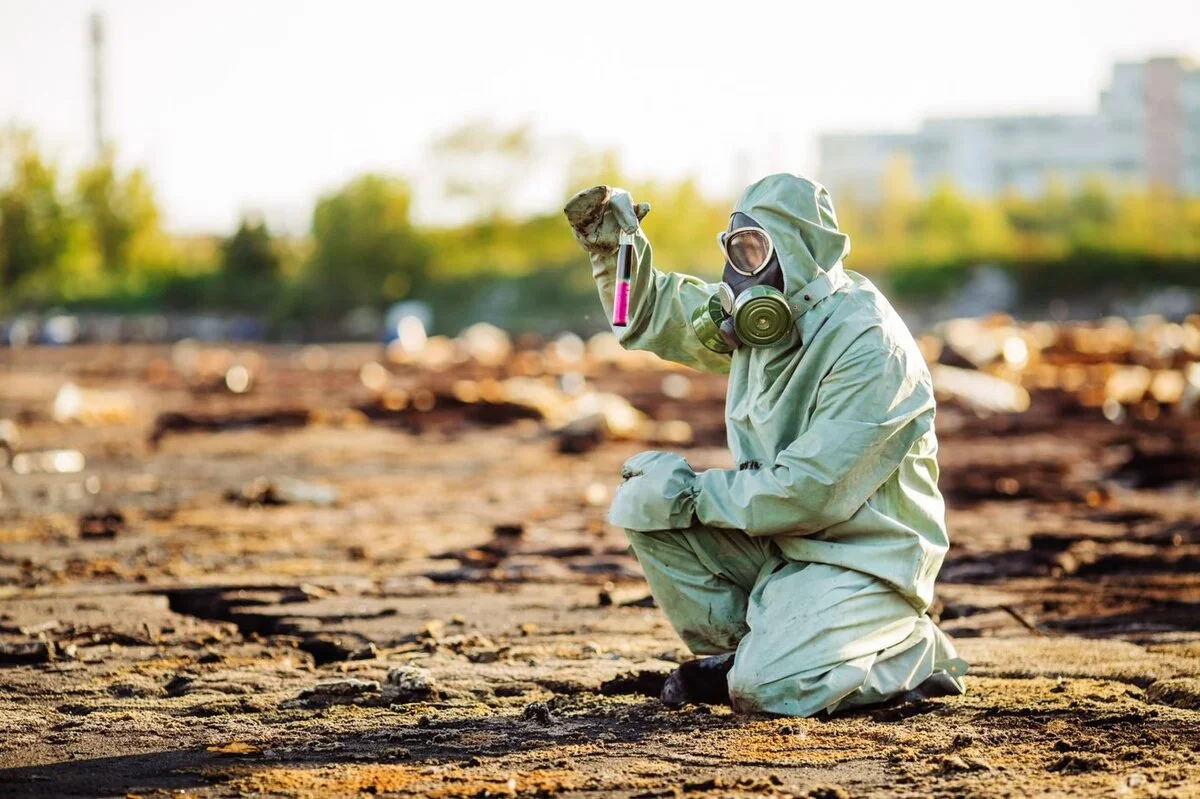
Another key element to hazardous substances is workplace exposure limits. Workplace exposure limits, also known as an occupational exposure limit, are levels of safe exposure to a hazardous substance in the air. Your employees could experience serious health effects if exposed to certain chemicals for too long. That’s why regulations have been put in place in to protect your people from harm.
These regulations include setting certain limits of exposure. This could range from Short Term Exposure Limits (STELS) of around 15 minutes to Long Term Exposure Limits of about 8 hours.
Dive into key elements of this topic in our blog, What is a Workplace Exposure Limit, including workplace exposure limits in the UK, occupational exposure limits in the EU, and how employers can manage exposure limits.
COSHH risk assessments
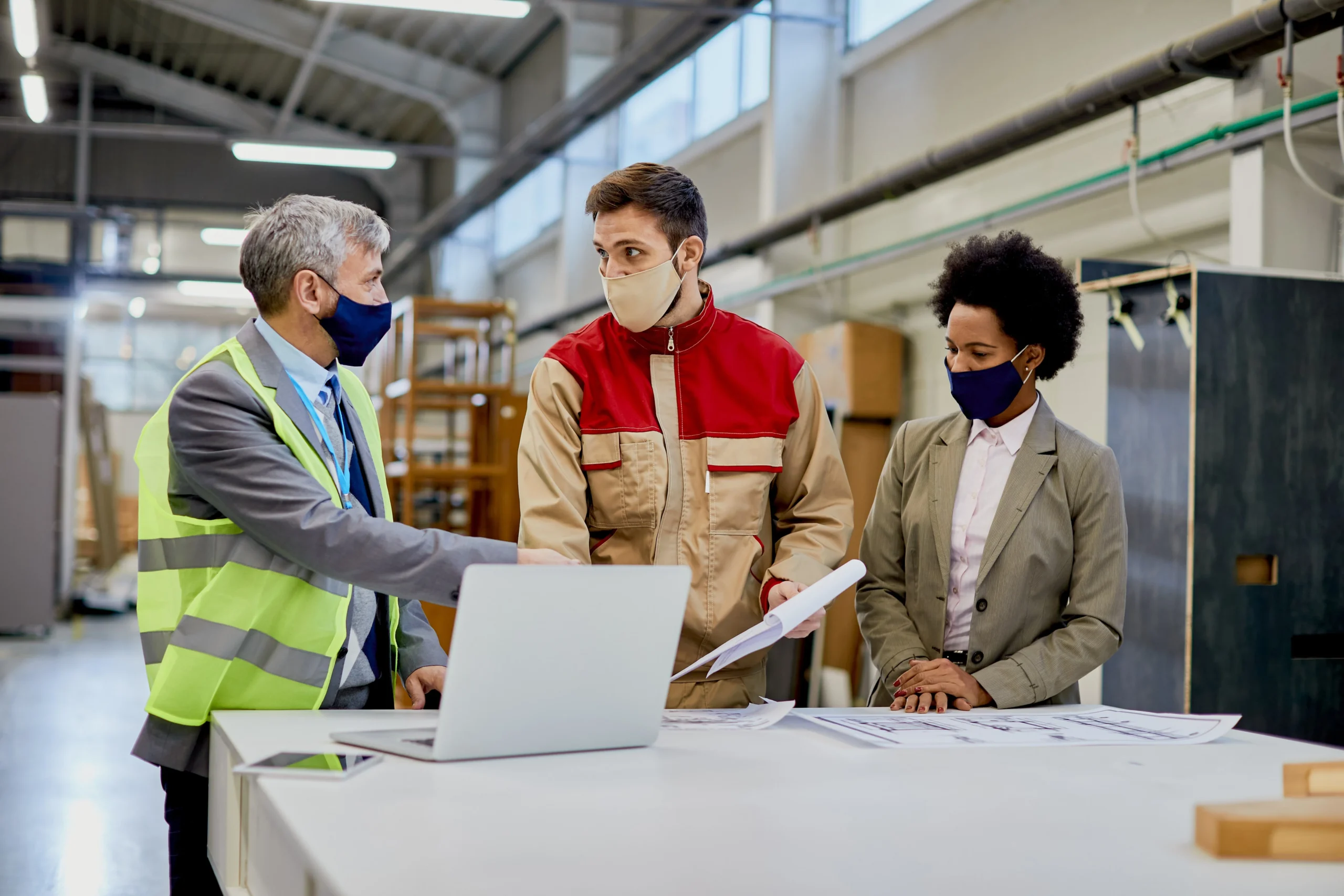
One of the most fundamental ways to keep your employees safe from exposure to hazardous substances is by completing a COSHH risk assessment. A COSHH risk assessment is when you evaluate a certain hazardous substance, including all the risks and hazards it may pose, who it may affect, and the control measures needed. Let’s examine exactly what this means and how to conduct it. It’s important to understand exactly how to create and write a COSHH assessment to efficiently protect your teams from hazardous substances.
Some of the most important elements to consider when writing your COSHH risk assessment are:
- Use: When completing a COSHH assessment you will need to include all tasks and activities related to the chemical and its use. Culture in your organisation in terms of safe use of chemicals, is key.
- Waste: Consider the transport of waste chemicals internally. How will these be transported? Where and how will they be stored?
- Storage: Are chemicals segregated in accordance with their associated hazards? Are chemicals stored above a recommended height? Is the packaging suitable for the chemicals stored within? These are all issues which could cause accidents or incidents in the workplace. Ensure all aspects of storage are considered when bringing new chemicals on site.
- Risk assessment vs. Individual risk assessment: Your COSHH risk assessment needs to be specific to the area where the chemicals are being used. Make sure to assess multiple different exposure scenarios for a given material. If this chemical is used in two different tasks, the COSHH assessment must have control measures for both tasks and have a unique risk rating for each. Staff using the product would need to be trained on this as well as the different usage types.
5 Steps to COSHH Risk Assessment Completion
1. Identify the hazards
This can easily be done by looking at the following areas:
- Safety Data Sheets – Look at section 2 of the SDS, as previously outlined
- Review hazards labels and COSHH symbols
- Examine toxicology reports
- Look at previous accident/incident reports
- Liaise with competent persons in your organisation or external members
2. Decide who may be harmed and how
- What activities give rise to exposure?
- How much of the substance is used?
- How many people are exposed? Don’t forget staff could be in adjacent areas.
- How long are they exposed to the substance?
- What is the workplace exposure limit for this substance?
- What are the routes of exposure?
- What current controls are in place? The most important thing is to be honest e.g: PPE is listed but people don’t use it. If that’s the case, then it’s not an acceptable control measure and another should be implemented.
3. Assess the risk and decide if any additional control measures are needed
Many organisations don’t assess the severity or danger for all their chemicals. From experience, the 5 x 5 risk matrix is a useful tool to identify risk levels. It outlines the severity of the chemical and the likelihood of an incident. Based on this evaluation a risk rating is assigned. The hazard level of a chemical is difficult to change, as this can only be attempted by diluting the chemical or substituting it for another less harmful chemical. We can however, reduce the likelihood of an incident happening by putting the right control measures in place.
Impact (severity) scale:
- Negligible: Adverse event leading to minor injury. Does not require first aid.
- Minor: Minor injury or illness, first aid treatment required. <3 days absence/<3 days hospital stay/emotional distress.
- Moderate: Significant injury requiring medical treatment. E.g.: fracture and/or counselling. Agency reportable. E.g. HSA, Gardai (violent and aggressive acts) <3 days absence/3-8 days extended hospital stay/emotional trauma.
- Major: Major injuries/long term incapacity or disability (loss of limb) requiring medical treatment and/or counselling /physical /emotional disability
- Catastrophic: Incident leading to death or major permanent incapacity. Event which impacts a large number of employees or members of the public. Emotional/physical trauma.
The preferred order of implementing control measures:
- Elimination: Could the exposure be eliminated all together by changing the task?
- Substitution: Could the substance be substituted for a safer alternative?
- Engineering controls: Could we make use of local exhaust ventilation (LEV)?
- Administrative controls: Could we use written procedures to highlight a safe way of working?
- Personal Protective Equipment (PPE): Look at section 8 within the safety data sheet, which has good insight and recommendations on the necessary PPE. Manufacturers are also able to provide detailed information.
Some typical control methods you can also think about including:
- Use a fume hood
- Source new machinery
- Reduce the quantity of chemicals used in processes
- Substitute for a less hazardous substance
- Use alternative technology
- Source a chemical spill kit
- Ensure all chemicals are labelled with GHS information
- Train employees on spill clean-up, first aid, and chemical safety
- Review PPE currently in use
- Provide PPE storage
4. Implement control measures
Once all the hazards, who they may affect, and controls are established, it’s time to implement the necessary control measures:
- Assign responsible individuals to implement control measures.
- Assign implementation date for controls.
- Review implementation of controls.
- Train employees on usage of controls measures.
5. Record, review and update COSHH assessments as appropriate
Once all the hazards, who they may affect, and controls are established, it’s time to implement the necessary control measures:
- Assign responsible individuals to implement control measures.
- Assign implementation date for controls.
- Review implementation of controls.
- Train employees on usage of controls measures.
All COSHH assessments must be documented and stored electronically (or otherwise) in the workplace. Distribute this information to employees and remind them of the identified risks in the area so they can make quick and safe decisions.
It’s also important to note that once a significant change occurs in a process, the regulation, etc., your COSHH assessment should be updated. This is an evolving live document which you should continuously look to improve at a regular cadence. The HSE says you should review your COSHH assessments at regular intervals. This could be based on your assigned risk ratings, for example.
The Ultimate Guide to COSHH Management

It’s time to dive into the eight steps you need to follow to build a successful COSHH management system. With over 20 years’ experience working with 6,000+ clients, we have learned that many different organisations and staff have varying levels of knowledge of chemical safety and best practices. Here are some of the most impactful steps we’ve seen.
8 Steps to COSHH Management
1. Develop a chemical safety policy
Chemical safety is often perceived by health and safety teams as intimidating and complex. This often makes it the last area to receive attention due to the nature of other tasks. Assumptions can often be made that members of certain departments have a high level of competency when it comes to chemical safety if they work in laboratories, for instance. It’s important not to make any assumptions, as regulations have changed over the years and constantly evolve.
To begin, you need to map out the organisation and the department structure. Ensure that you thoroughly document and cover all aspects of chemical safety. Share that knowledge with staff and ensure to train and retrain all staff members to a sufficient level of competence so they can make safe choices. Assign roles and responsibilities to all employees where necessary (emergency response, storage, handling). Having a complete overview of chemical safety within your organisation will give you a clearer picture and help put your mind at ease.
2. Build your chemical inventory
It’s vital to have an accurate chemical inventory to work with. How many sites, and how many departments do you have? What chemicals do you have in each location?
- List all departments on the site regardless of chemical use. It’s possible there are chemicals present you are not aware of.
- Allow for multi-site structure if required.
- Design a consistent chemical inventory template for use across the organisation. You must collect the full product name along with the catalogue code. This is essential, as it allows you to source the most up to date safety data sheet for each product. You can download our Chemical Inventory Template by clicking here.
- Collect product information by department and store it centrally. This will prevent you from doing the same work on multiple occasions, and it’ll also help you control the information being gathered. This will also be useful in terms of getting the right safety data sheet for the product you are using and not a variation.
- Use a consistent naming system for chemicals. For instance, note the full product name – e.g. “Bleach” vs. “Domestos Bleach Original”.
- Document the full manufacturer/supplier name.
3. Source safety data sheets
An SDS is a very important and informative document which allows you to assess hazards associated with the products in use. The law requires that all chemical suppliers provide an SDS for a hazardous mixture they wish to supply. SDSs should be available where the chemicals are in use.
It’s important that all staff have read the SDS concerning all the chemicals they are working with. Upon receipt of the SDS, it’s important to check the document to ensure it’s in compliance with the applicable legislation in the country where it’s in use i.e. UK SDSs should be CLP and REACH compliant.
Does your staff know what an SDS is? Employers should provide some basic awareness on this. For example, section 4 covers First Aid. Does your staff know this? If not, the safety data sheet will not be useful to employees using the chemicals.
All sections of an SDS are important, however, the most useful sections that staff should have knowledge on is the information displayed in sections 1-10. Safety data sheets must be provided either electronically or as a hard copy.
Manufacturers/suppliers will usually provide SDSs with the product, either electronically or as a hard copy. If possible, source the SDS before the product is brought on site in order to review the hazards and determine if it’s suitable (we will cover this in more detail later). Record basic information related to the product in your inventory. This will help you maintain control of the chemicals you have on site.
4. Design a COSHH template
Keep your COSHH template simple and relevant. Avoid long and lengthy pages and use as many multiple-choice options as possible. Free text is slow and encourages “copy & paste” from safety data sheets. This does not allow for the evaluation of the hazards.
One of the biggest mistakes we see in COSHH Assessments is generic information being filled as a box ticking exercise, which has no significance for the job in question.
You can pre-populate certain sections with approved statements for all controls/procedures that are most relevant to each location on your site (first aid, fire, ppe, etc.). Remember to put your brand-logo on the template. It differentiates the document from an SDS and highlights ownership of the document within your organisation.
5. Write COSHH Risk Assessments
COSHH Risk Assessments are a necessary part of evaluating the possible substances hazardous to health in your organisation. Who will create these COSHH Assessments? Let’s take a look at the following four options.
- Completed by EHS with no input from staff: Creating a COSHH risk assessment in an office and not on the ground, is not advisable as it is often not specific to the location and task. In this scenario, the creation of the assessment has not been informed by the lived experience of people carrying out this task.
- Completed by staff with no input from EHS: This is the reverse of the above scenario. Creating a COSHH assessment without EHS input, excludes valuable expertise and could lead to inconsistencies in quality.
- Completed by staff – signed off by EHS: This scenario can speed up the completion of COSHH assessments but could lead to delays and inconsistencies in quality. This option works best when all staff have had some basic level of COSHH assessment training.
- Completed by EHS in conjunction with staff: This is a scenario that is recommended, as staff are actively collaborating with EHS to complete the risk assessments. This ensures nothing is left out and everything is documented as it should be.
6. Distribute information
COSHH assessments must be accessible to all staff, ideally electronically. Distribute assessments and safety data sheets to employees in a timely manner. The completion of COSHH assessments is vital to ensure the health and safety of staff involved.
A common mistake organisations make is once the documents are completed, they are placed in a folder until they require review again. These are documents which you should continuously improve at a regular cadence, as previously mentioned.
- Soft copies: Distribute soft copies to your organisational network, ideally through a document management system with features to allow for search, revision control, etc.
- Hard copies: If it’s not possible to provide soft copies, they should be provided via hard copy (printed).
In particular, these are required in areas that do not have access to systems. Strict procedures must be put in place to ensure they are kept up to date with soft versions. Ensure multiple revisions of the same document are not available to staff to avoid confusion.
7. Purchase new products
In our experience, this is one of the most important aspects you need to get right for chemical safety and COSHH management to be successful. The rationale behind this is when you purchase a chemical, you are often going to be using that chemical for 5, 10, or maybe even 15 years. Do you consider the potential impact of implementing control measures for that product for that length of time?
To understand how that chemical may affect your process, it’s important to complete your COSHH assessment early on i.e. before the chemical comes on site. Liaise with your supplier to ascertain all key information on the product and check the SDS.
There are a number of areas to consider during procurement including:
- Fit for purpose
- Supplier
- Possibilities for elimination of exposure
- Substitution with safer alternatives
- Smaller sized containers for more hazardous substances
- Approval processes for new chemicals
8. Maintain and update safety data sheets
- Check for up-to-date safety data sheets with manufacturers –preferably on an annual basis.
- Archive old versions of safety data sheets. (Ensure staff only have access to the latest version).
- Centralise your inventory where possible.
- Update COSHH Assessments in line with revised SDSs.
- Put procedures in place to review COSHH assessments on an annual basis.
The European Chemicals Agency, or ECHA, are reviewing and revising the classification of substances on an ongoing basis, so it’s essential that you have the most up to date safety data sheet to reflect such a change. If for example, something changes from an irritant to a corrosive substance, you must update your COSHH Assessments accordingly, as it poses a different risk.
Individual departments should review and update inventory lists accordingly, but it’s essential that the SDS is managed centrally. The workload to implement a good COSHH system is significant and requires a lot of hours and input. Some companies work hard to get COSHH management updated to a good place and then they feel the work is complete. This should not be the case.
It’s an ongoing battle to maintain the quality of your COSHH system. If a product classification changes or you stop sourcing updated SDSs, then you increase the risk to your staff members and open your company up to a damaged reputation, lawsuits, and even closure.
How to manage chemical risk
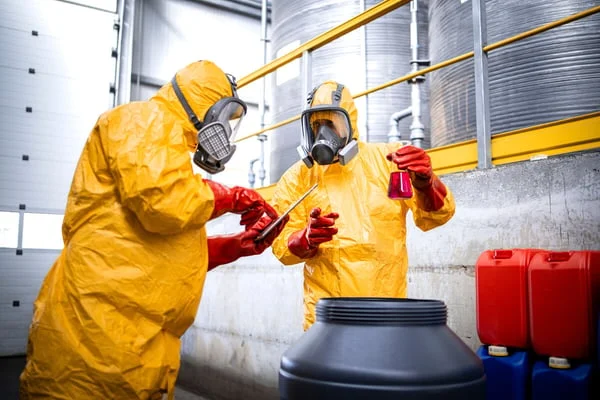
Managing COSHH and different aspects of chemical safety can be a challenging task, especially if you’re using paper. Paper-based systems or Excel spreadsheets can lead to time-consuming manual processes and a lack of standardisation. It also makes it extremely difficult to uncover gaps in compliance and communicate efficiently with your teams. This leads to a reactive approach to safety, which is not in your organisation’s best interest.
3 common mistakes of hazardous substances management
We’ve teamed up with global law practice Eversheds Sutherland to share the common mistakes organisations making when managing hazardous substances.
With an ever-increasing focus on the protection of workers’ health, the management of hazardous substances is arguably higher on the business agenda than ever before. However, many organisations still fall foul of basic mistakes when implementing COSHH (Control of substances hazardous to health) processes to protect staff from the dangers of work-related ill health.
Moyna Merrison, Director of COSHH specialists EcoOnline Sypol, highlights three of the most common mistakes businesses make:
1. “I have a list of hazardous substances and how they should be used, so I’m compliant”
Understanding the substances that are used within your business is just half of the COSHH challenge. Every business needs to document what substances are being used and, more importantly, how they are being used. A compliant COSHH assessment needs to detail how a substance is being used, for how long, in what type of environment and what protective measures need to be taken. This information then needs to be effectively communicated to the staff so that they understand what precautions need to be taken to protect their health.
2. “I reviewed my COSHH assessments a few years ago, so I don’t need to do anything”
Effective COSHH management should be a cyclical process of continuous improvement – it is not a static task that should only be done once. Legislative updates, the introduction of different products or substances and personnel changes can all have a fundamental impact on a COSHH assessment.
Businesses who are not proactively reviewing their COSHH assessments may as well not have any assessments in place at all.
3. “I’ve never had a COSHH incident, so my business doesn’t have a problem”
Ignorance is no excuse for failing to implement a robust COSHH management strategy. The symptoms of many occupational diseases caused by hazardous substances – lung cancer, occupational asthma, joint and nerve damage – can take several years to emerge.
Therefore, while a business may not have had an incident to date, that doesn’t mean that its COSHH processes are effective. And if a worker develops an occupational disease in the future that can be related to a job they did in the past, their former employer will still be held responsible.
What are the legal implications of non-compliance?
One of the Health and Safety Executive’s (‘HSE’) current priorities is on occupational health, with a particular focus on occupational lung disease, given the disease leads to an estimated 12,000 deaths each year. Health and safety lawyer, Elizabeth Hyde, Principal Associate at Eversheds Sutherland comments:
“Under UK health and safety law all the HSE has to prove in order to bring a prosecution against a company is that the company has posed a risk to the health and safety of its employees or to those affected by the company’s activities. The HSE does not have to demonstrate that actual harm has occurred. Companies therefore run the risk of prosecution if they fail to properly implement effective COSHH processes.”.
Personal Injury lawyer, Louise Bland, Partner at Eversheds Sutherland adds:
“Failure to carry out effective COSHH assessments will also leave businesses highly vulnerable to injury claims. Whilst injury claims are often insured, claims arising as a result of a poor COSHH management strategy may result in increased insurance premiums and more importantly threaten damage to brand and reputation”.
COSHH assessment software
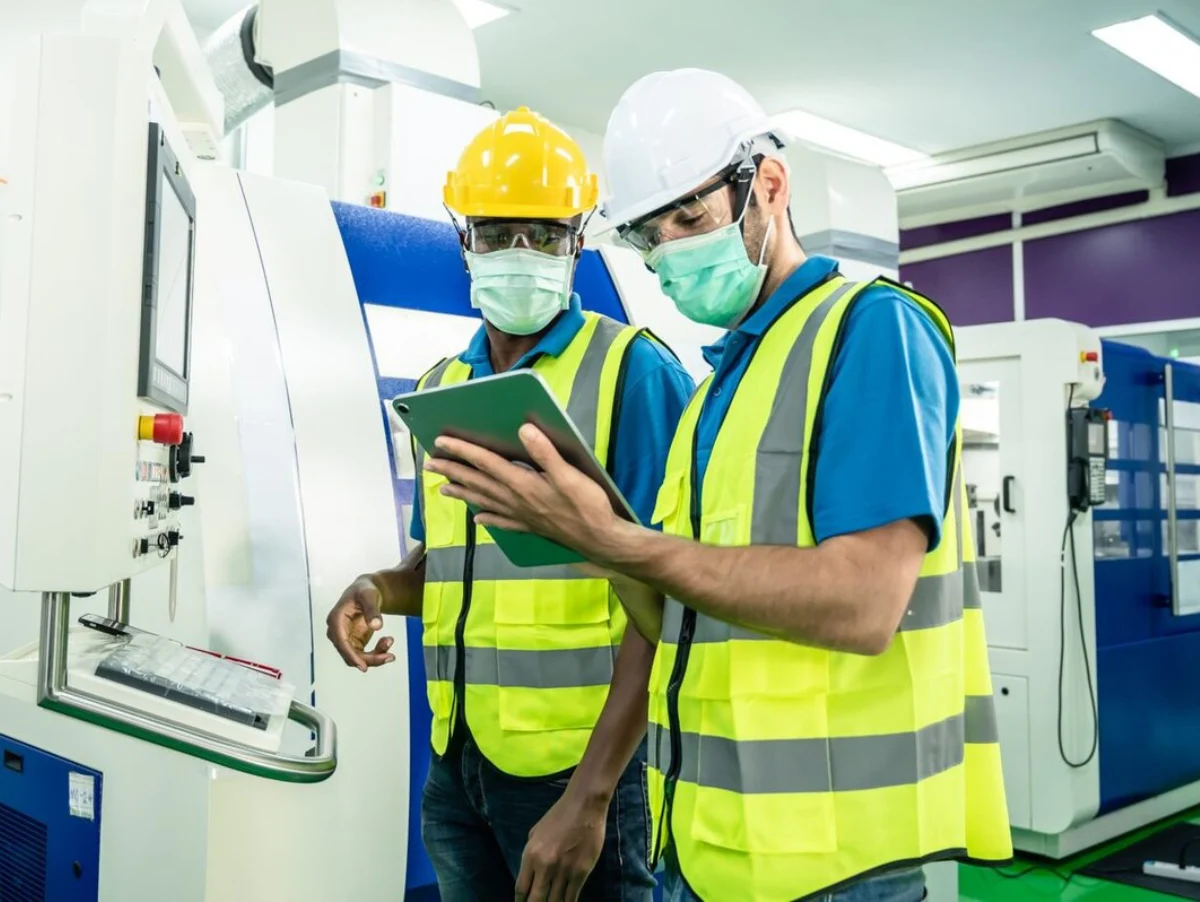
COSHH management can be a challenging task, so let EcoOnline’s COSHH management software do the heavy lifting!
A digital safety solution can allow you to simplify your COSHH processes and build a successful COSHH management system. Chemical safety software enables you to easily source safety data sheets directly from the manufacturer and create custom, compliant, and relevant COSHH Risk Assessments – no more Excel spreadsheets needed! It will also help you communicate the latest information in your COSHH database to your employees, so they are always aware of any updates. Ensure the safety of your employees with real-time chemical reporting data and streamlined safety data sheet management.
Imagine having the ability to complete your COSHH assessments online with a few simple clicks in EcoOnline’s COSHH management software. With this COSHH tool in the palm of your hands, you can help streamline the elements needed to create a safer work environment for your people.
COSHH Case Study

Questioning whether our COSHH assessment software is right for you? Müller, a multi-national company, employing over 20,000+ employees across Europe relies on EcoOnline’s COSHH assessment system to help manage substances hazardous to health and stay compliant across multiple sites.
Müller also uses our COSHH risk assessment software to standardise chemical assessments across the organisation. Our COSHH consultants have been an asset to keeping Müller up to date and on track with any new or changing legislation.
Find out more about how EcoOnline has helped this organisation simplify COSHH compliance and management by reading their story.





